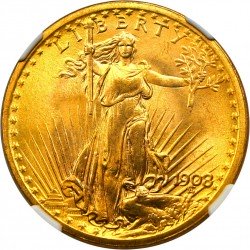

The 1908 St. Gaudens $20 Gold Coin is named for its designer, Augustus Saint-Gaudens. St. Gaudens was a noted sculptor who was appointed by President Theodore Roosevelt to redesign the Gold Coin. The first Saint-Gaudens double eagle was struck in 1907, but the design was soon modified to make the striking of the coin, which was originally made in high relief, more efficient.
The motto “IN GOD WE TRUST” on some coins created a variety of sorts among the 1908 Saint-Gaudens $20 Gold Coin. Accordingly, many coin collectors will try to assemble a collection that includes both the no-motto and motto-bearing double eagles from that year.
Though these coins have since been taken off the production lines, they remain extremely popular amongst collectors from both the US and abroad.
For collectors, the goal always is to add only the most well-preserved pieces to collections. Everyone strives to have the most attractive collection, but with St. Gaudens $20 Gold Coins, this is not so easy to accomplish. The reason for this is due to the fact that these coins are so old and have had ample opportunity to become worn and damaged.
Normally, a person who would like to have the condition of their coins judged would send the coin away for grading by a professional organization. Understanding that not everyone has the time or money to do this, we have elaborated on the most popular coin grades below.
Uncirculated: If a coin is determined to be Uncirculated, this means that it did not ever exchange hands, or exchanged hands for only a very short period of time. These coins will appear to have been just minted and will have retained all of their original texture and imagery. For collectors, these are often the most expensive coins on the market.
Extremely Fine: A coin that is determined to be of Extremely Fine grade is one that spent only a limited amount of time being circulated. These coins will play host to some extremely light surface wear, but apart from that will be in pristine condition. These coins are also up there as far as price is concerned, but their pleasing aesthetic qualities help explain the higher price tag.
Fine: If a coin is determined to be of Fine grade, this means that the piece in question was circulated for a period of time and damaged to some extent. Realistically, the damage you will find on these coins is not severe, but you will notice a wearing down of the coin’s texture as well as some consistent light scratching.
Good: Good is the lowest grade a coin can receive and is usually indicative of a piece that has been quite heavily circulated throughout its lifetime. These pieces will play host to some heavy scratching, and on occasion the coin itself will even be chipped or bent. Being that 1908 St. Gaudens $20 Gold Coins are so old, it is not at all uncommon to find pieces in this shape.
As far as determining a price for the Morgan Dollar is concerned, there are a few factors that you must look at. For one, there were multiple types of the St. Gaudens $20 Gold Coin minted every year, and this means that the price will vary from type to type. Secondly, the condition of the coin means everything to collectors and is something that will also play heavily into the coin’s asking price. Below is a chart aimed at giving you a better idea of what you can expect to pay for a St. Gaudens $20 Gold Coin given its condition and type.

St. Gaudens $20 Gold Coin
| DATE | GOOD | FINE | EXTREMELY FINE | UNCIRCULATED |
|---|---|---|---|---|
| 1908 St. Gaudens $20 Gold Coin | N/A | N/A | $11,000 | $12,000 |
| 1908 St. Gaudens $20 Gold Coin (D) | N/A | N/A | $1,475 | $1,485 |
| 1908 St. Gaudens $20 Gold Coin (S) | N/A | N/A | $3,750 | $6,000 | Source: Red Book |